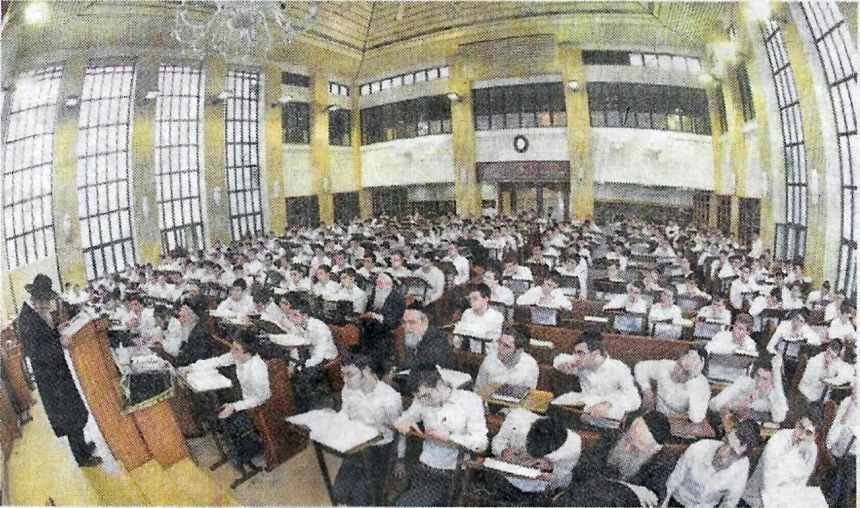| |
This Google Custom Search looks only
in this website.
HaRav Dov Lando's Message: You Need Mitzvos and Torah
In a very significant and uplifting visit, HaRav Dov Lando, Rosh Yeshivas Slobodka, delivered a rousing shiur klalli at Yeshivas Ohr Yisroel on Maseches Pesochim which is currently being studied there. The subject was [kol sheino etc.], also regarding the laws of chodosh and matzo from untithed flour. His audience was comprised of hundreds of the talmidim as well as by the presence of the Rosh Yeshiva, HaRav Yigal Rosen, and the other roshei yeshiva.

Bonei Olom: Chessed to Families
A very important and impressive gathering took place in the home of HaRav Moshe Shternbuch, Raavad of the Eida Chareidis in Jerusalem, with the participation of the members of the Halacha Committee of Bonei Olom, as well as the chairman and founder of the World Bonei Olom Organization, Rabbi Shlomo Bochner, from the U.S. He is here in order to promote and expand its activities for the sake of the thousands of couples being helped by Bonei Olom.

The Husband's Responsibility for Tsnius in the Home
[An excerpt from BaMesilah HaOlah, a collection of essays about correct Torah outlook and mussar]
This timely essay was originally published 26 years ago in Sivan 5755/1995.
For an essay of this nature, namely one that discusses tsnius, the above title ("And tell Bnei Yisroel," from Shemos 19:3) may seem a misnomer because this part of the posuk refers to the men. The beginning of the posuk, "And this is how you should talk to Beis Yaakov," refers to women, and one might expect that this should have been chosen as the title for this piece. Instead I preferred to choose the end of the posuk, "And tell Bnei Yisroel," basing the choice on the Mechilta's interpretation that such "telling" denotes harsh words [`as tough as sinews' — Rashi] that should be transmitted to the men. Our title therefore comes to emphasize the obligation of husbands to supervise all matters of tsnius in their homes.

* * *
|
From Our Archives |
|
Signs of Distinction: Creating the Shabbos Atmosphere
by Rabbi D. Travis
After a full day's journey, you finally arrive at the royal palace. Entering the gates, you gaze in amazement at the breathtaking magnificence of these regal surroundings. The closer you get to the king's chamber the more awestruck you become by the stunning architecture, the lavish tapestries and the ornate furniture. Finally you enter the king's chamber. Upon the royal throne sits the monarch bearing a diamond- studded scepter, crowned in splendor and glory.
Palaces, thrones, crowns and scepters all distinguish and set apart the king from the rest of his nation. On Shabbos we find ourselves in the presence of the Shabbos Queen. How should we behave to show the proper honor to Hashem's Royalty?
" . . . And you shall honor it [Shabbos], by not following your own ways, not pursuing business, and not speaking about vain matters" (Yeshaya 58:13). Just as a person going to speak to the king must make sure that his clothing, speech, and every action are aimed at honoring the monarch, so too we are directed to distinguish Shabbos from the rest of the week through changes in our apparel, speech and even the way we walk.
|
Braided Pathways
by Shira Levy
Part I
She ran as fast as she could, through the grass, past the trees by her back porch, the wind blowing against her face with a raw force that thrilled her. "I'm a bird! I'm free! I'm flying and my skirt is a wing fluttering in the wind..."
She loved this skirt. Her mother had let her pick out the material and she had watched as her mother made it. And now this skirt was like angel wings.
"Gavriella!"
Gavriella froze -- right in the middle of the vegetable patch. She hated it when her mother used that tone of voice, the one she used when Gavriella misbehaved as a child.
Her mother was wiping her hands on a towel. "You're much too big to be running wild like that!"
Gavriella felt stunned. Wild? She wasn't being wild. Her heart began to fill with bewilderment. She was confused.
|
|
POPULAR
EDITORIALS
Av, 5765 - Kislev 5766 (August-December 2005)
|






.jpg)


